Difix3D+
Improving 3D Reconstructions with Single-Step Diffusion Models (CVPR 2025)
Difix3D+ - Improving 3D Reconstructions with Single-Step Diffusion Models (CVPR 2025)
Jay Zhangjie Wu, Yuxuan Zhang, Haithem Turki, Xuanchi Ren, Jun Gao, Mike Zheng Shou, Sanja Fidler, Zan Gojcic, Huan Ling
paper :
https://arxiv.org/abs/2503.01774
project website :
https://research.nvidia.com/labs/toronto-ai/difix3d/
핵심 :
nearly real-time single-step 2D diffusion model을
3D artifacts removing task에 맞게 fine-tune한 뒤,
3D model에 distill하여 progressively update하거나
post-processing으로 씀!
Contribution

- Difix3D+ 설명 :
- Stage 1)
sparse view로 학습된 못난 3D model로 rendering한 novel-view의artifacts를 제거하도록
single-step 2D diffusionmodel (Difix)을minimal fine-tuning - Stage 2)
fine-tuned Difix를 이용하여
3D model로 distill하거나 post-processing- Difix 역할 1)
reconstruction at training phase:
fine-tuned Difix를 적용하여 clean pseudo-training views (training set)을 iterativelyaugment함으로써
fine-tuned Difix의 prior를 3D model로distill - Difix 역할 2)
neural enhancer at inference phase:
single-step 2D diffusion model은 inference speed 빠르므로
남은 residual artifacts를 제거하기 위해 improved recon. output에 직접 Difix 적용
(near real-time post-processing)
- Difix 역할 1)
- Stage 1)
- Difix3D+ Contribution :
-
single-step diffusion model:
ADD (Adversarial Diffusion Distillation)으로 학습된 single-step diffusion model은
single-step만 U-Net을 query하므로 inference speed 빠름 -
minimal fine-tuning:
그래서 fine-tuning하는 데 single GPU로 only a few hours만 필요 -
generalmodel :
모든 3D models (NeRF, 3DGS 등)에 사용 가능한 single model - metrics :
- artifacts 제거(fix)하므로 3D consistency 유지한 채 FID score 2배 이상 및 PSNR 1dB 이상 향상
- single-step diffusion model을 사용하므로 multi-step standard diffusion model보다 10배 이상 빠름
-
Introduction
- 현재 NVS methods의 한계 :
per-scene optimization framework- input이
sparse하거나
input camera poses로부터 먼extreme novel view를 rendering하거나
varying lightingconditions 또는imperfect camera poses상황에서
spurious(가짜) geometry 또는 missing regions 등 artifacts 생김 - underlying geometry를 제대로 반영하지 못한 채 (incorrect shape)
inherent smoothness에만 의존하는 3D representation으로도
training images’ radiance에 overfitting되는
shape-radiance ambiguity문제
- input이
- large 2D generative model :
- 2D diffusion model prior :
large internet-scale data를 학습하여 real-world images의 distribution을 잘 이해하고 있으므로 diffusion priors는 여러 분야에 generalize 가능- inpainting
[1] [2] [3] - outpainting
[4] [5] [6]
- inpainting
- 2D diffusion model prior to 3D :
-
multi-step으로 U-Net을 query[7] [8] [9] [10] :
object-centric scenes를 optimize하고, more expansive camera trajectories를 가진 larger env.로 scale하는 데 사용
But,,time-consuming! -
single-step만 U-Net을 query[11] [12] [13] [14] [15] [16] :
inference speed 빠르고,
minimal fine-tuning만으로도 extreme novel-view에서도 NeRF/3DGS rendering의 artifacts를 “fix”할 수 있음!
-
- 2D diffusion model prior :
Related Work
- 3D recon. 개선 :
imperfect noisy input data에 대응하기 위해-
optimize camera poses[17] [18] [19] [20] [21] [22] -
lighting variations고려[23] [24] [25] -
transient occlusions완화[26] - 위 방법들의 한계 :
완전히 artifacts를 해결하진 못함
-
- Priors for NVS :
under-observed (잘 보지 못한) 영역들을 잘 recon.하지 못하는 문제를 해결하기 위해-
Geometric priors:
noise에 민감하고, dense input일 때만 미미한 개선- by
regularization term[27] [28] [29] - by
pre-trained modelswhich providedepth GT[30] [31] [32] [33] andnormal GT[34]
- by
- 여러 scenes’ data로
feed-forward neural network훈련 :
이웃한 reference views의 정보를 aggregate하여 reference views 근처에서는 잘 수행하지만,[35] [36] [37] [38] [39]
rendering 분포가 inherently multi-mode를 가지는 ambiguous regions에서는 잘 못 함
-
- Generative Priors for NVS :
- GAN :
NeRF 개선하기 위해 per-scene GAN 훈련[40] - Diffusion :
- diffusion model이
직접 novel view를 generateby minimal fine-tuning[41] [42] [43] [44] :- 단점 : 3D model을 사용하지 않으므로 generative nature leads to
multi-view geometric inconsistencyacross different frames/poses, especially in under-observed and noisy regions
- 단점 : 3D model을 사용하지 않으므로 generative nature leads to
- diffusion model이
3D model의 optimization을 guide[45] [46] [47] [48] [49] - 단점 :
multi-step으로 U-Net을 query (denoise)해야 해서 훈련 많이느림
- 단점 :
- diffusion model로 training image set을 augment하여 3D model을 fine-tuning
[11] [50] [51] :
(위의 두 방법을 합친 느낌?!)- 본 논문 : 어설픈 3D model의 output에 대해 2D diffusion model (U-Net)을 먼저 fine-tuning한 뒤
diffusion model로 training image set을 augment하여 diffusion prior를 3D model로 distill (fine-tuning)하거나
diffusion model로 post-processing
- 본 논문 : 어설픈 3D model의 output에 대해 2D diffusion model (U-Net)을 먼저 fine-tuning한 뒤
- diffusion model이
- GAN :
Overall Pipeline
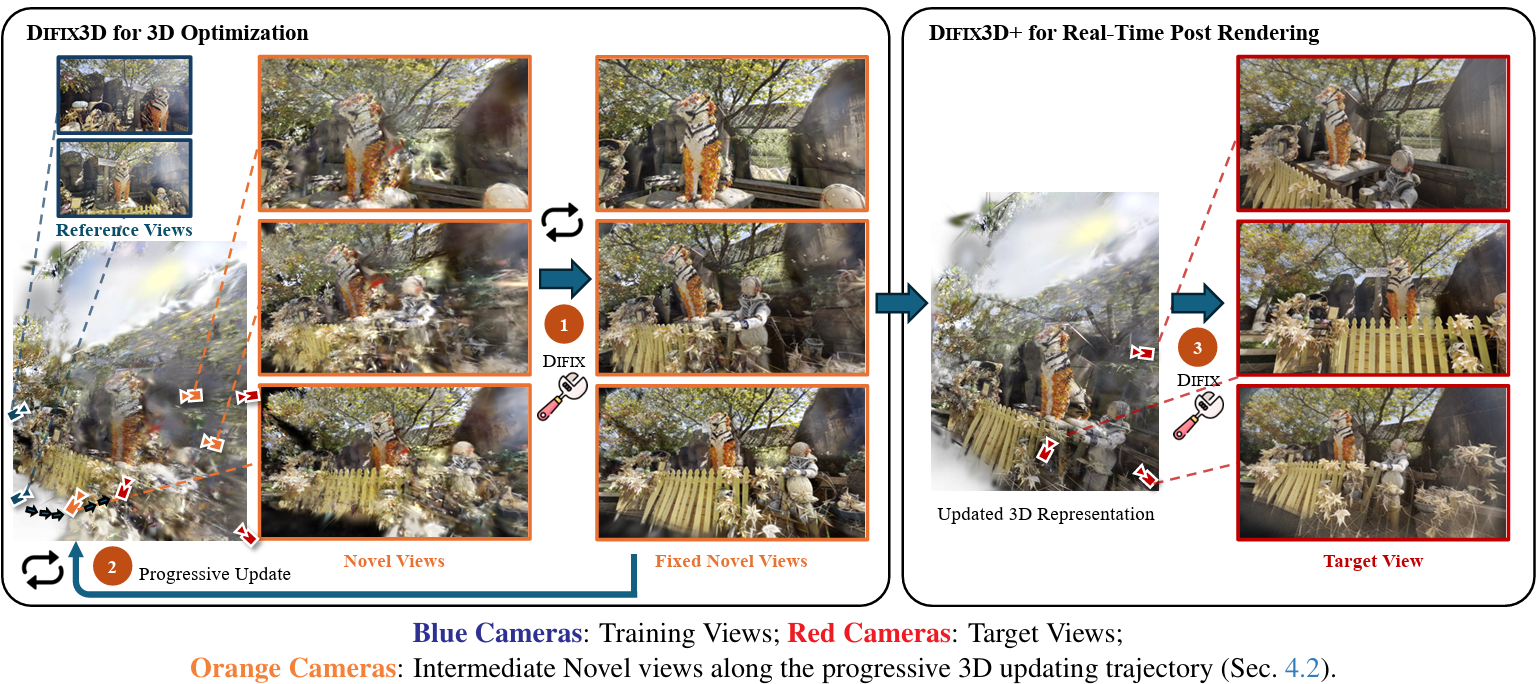
- Architecture :
- Stage 1)
single-step 2D diffusion model (Difix)을 minimal fine-tuning - Stage 2)
- Step 1)
Difix로 clean pseudo-training views (training set) 얻음 (augment!)
이 때, novel camera pose는 reference view부터 target view까지의 경로를 따라 pose interpolation으로 얻음 - Step 2)
cleaned novel view를 이용하여 diffusion prior를 3D model로 distill- Step 1, 2를 반복하여 progressively update 3D representation
(recon.하는 공간 크기를 키우고 diffusion model의 strong conditioning을 보장하기 위해)
- Step 1, 2를 반복하여 progressively update 3D representation
- Step 3)
final updated 3D representation으로 rendering한 output을
Difix로 real-time post-processing
- Step 1)
- Stage 1)
Difix - from a Pretrained Diffusion Model to a 3D Artifact Fixer
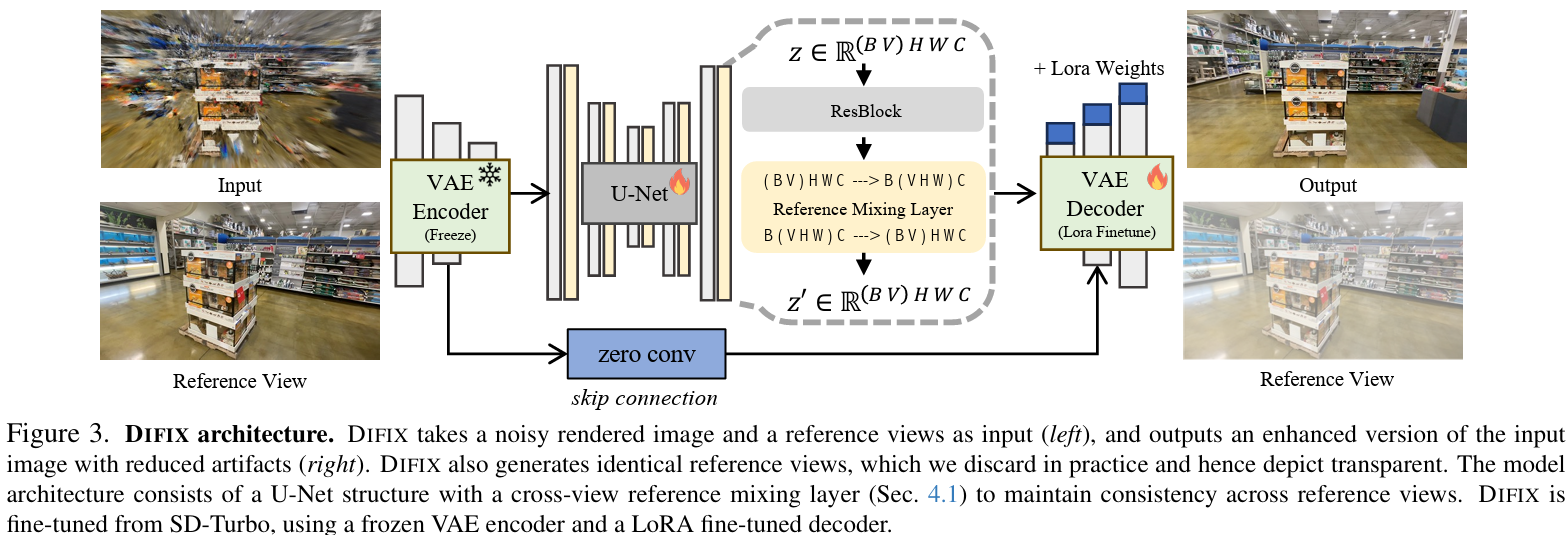
- based on
SD-Turbo[14] :
SD-Turbo는single-step diffusionmodel이라서 image-to-image translation task[52] 를 effectively 수행 가능
Fine Tuning
위의 Overall Pipeline에서 Stage 1)에 해당되는 내용!
- Fine Tuning :
single-step 2D diffusion model인 SD-Turbo[14] 가 3D Artifact Fixer 역할을 할 수 있도록
Pix2pix-Turbo[52] 와 유사한 방식으로 fine-tune- I/O :
- input : clean reference view \(I_{ref}\) and degraded rendered target view \(\tilde I\)
- output : clean reference view \(I_{ref}\) and clean target view \(\hat I\)
(training 및 inference에는 clean reference view \(I_{ref}\) 만 사용)
- architecture :
frozen VAE encoder - U-Net - reference mixing layer (self-attention layer) - LoRA fine-tuned decoder- frozen VAE encoder :
reference view \(I_{ref}\) 와 degraded target novel view \(\tilde I\) 를 latent space로 encode한 뒤 concat
as \(\epsilon (\tilde I, I_{ref}) = \boldsymbol z \in R^{(B \ast V) \times H \times W \times C}\)
where \(V\) : the number of views (reference views and target views)
where \(C\) : the number of latent channels - U-Net
- reference-view conditioning by reference mixing layer (self-attention layer) :
\(\boldsymbol z \in R^{B \times (V \ast H \ast W) \times C}\) 로 reshape한 뒤
\(V \ast H \ast W\) dimension (dim=1)에 대해self-attention layer를 적용하여
reference view 간의 cross-view consistency를 포착
(특히 rendered target novel view의 퀄리티가 좋지 않을 때
함께 input으로 넣어주는 clean reference view로부터objects, color, texture 등 key info.를 잘 포착할 수 있음!) - LoRA fine-tuned decoder
- frozen VAE encoder :
- 디테일 :
lower noise level (e.g. \(\tau = 200\) instead of \(\tau = 1000\)) 부여
s.t. diffusion model generates less-hallucinated results (덜 상상하며 생성) - 아이디어 :
a specific noise level \(\tau\) 에서
3D model이 rendering한, artifacts를 가진 images의 분포는
원래 diffusion model을 train하는 데 사용한, Gaussian noise를 가진 images의 분포와유사할 것이다! - loss :
\(L = L_{Recon} + L_{LPIPS} + 0.5 L_{Gram}\)- \(L_{Recon}\) : L2 loss
- \(L_{LPIPS}\) : perceptual loss (VGG-16 features끼리 비교)
- \(L_{Gram} = \frac{1}{L} \sum_{l=1}^{L} \beta_{l} \| G_{l}(\hat I) - G_{l}(I) \|_{2}\) :
style loss for sharper detail (VGG-16 features의 Gram matrix끼리 비교)
where \(G_{l}(I) = \phi_{l}(I)^{T} \phi_{l}(I)\)
where \(\hat I\) (rendered noisy image) - \(I\) (GT clean image) pair는 아래에서 설명할 Data Curation 방법으로 생성
- I/O :
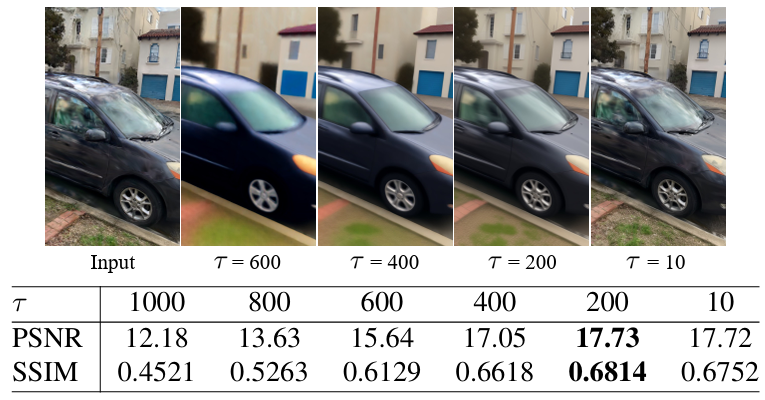
noise level이 높으면 model은 artifacts를 잘 제거하지만 image context도 함께 바꿈,, noise level이 낮으면 model은 image를 거의 안 건드림
Data Curation
- Data Curation :
single-step 2D diffusion model SD-Turbo 를 fine-tuning하기 위해
loss \(L = L_{Recon} + L_{LPIPS} + 0.5 L_{Gram}\) 를 사용하려면
novel-view synthesis artifacts를 가진 image \(\tilde I\) 와
이에 대응되는 깨끗해진 GT image \(I\) 를
pair로 가진 large dataset를 구축해야 함- 방법 1) sparse reconstruction strategy :
every \(n\)-th frame을 3D model training에 사용한 뒤
나머지 frames를 GT로 삼고, 해당 pose에 대해 novel-view-synthesis 수행하여 \(I\) - \(\tilde I\) pair 구축- DL3DV dataset 처럼 camera trajectory가 있어서 novel views를 띄엄띄엄 sampling한 경우에는 잘 적용됨
- MipNeRF360 또는 LLFF dataset 처럼 training에 사용할 every \(n\)-th frame이 거의 같은 영역을 보고 있는 경우에는 최적의 방법이 아님
\(\rightarrow\) 그럼 training sample 수를 최대한 늘리려면 어떻게 할까?
\(\rightarrow\) 아래의 방법들 사용
- 방법 2) cycle reconstruction :
Internal RDS (real driving scene) dataset 처럼 거의 linear trajectory인 경우
original trajectory를 \(T_{o}\)라 하고, 이를 horizontally 1-6 m 옮긴 trajectory를 \(T_{s}\) 라 하면
NeRF-1을 \(I\) on \(T_{o}\) 에 대해 학습한 뒤 \(T_{s}\) 에 대해 NeRF-1을 rendering한 뒤
these rendered views on \(T_{s}\) 에 대해 NeRF-2를 학습한 뒤 \(T_{o}\) 에 대해 NeRF-2를 rendering한 걸 \(\tilde I\) 로 사용 - 방법 3) model underfitting :
artifacts 더 많은 \(\tilde I\) 를 generate하기 위해
기존 training schedule epoch 수의 25%-75% 정도로만 훈련시켜서
render \(\tilde I\) with underfitted recon. - 방법 4) cross reference :
multi-camera dataset의 경우에는
그 중 하나의 camera로만 3D model을 학습시킨 뒤
나머지 camera view \(I\) 에 해당되는 pose에 대해 render \(\tilde I\)
- 방법 1) sparse reconstruction strategy :

Difix3D+ - NVS with Diffusion Priors
Difix3D - Progressive 3D Update
위의 Overall Pipeline에서 Stage 2)의 Step 1), 2)에 해당되는 내용!
- Progressive 3D Update and Reference-View Conditioning :
- desired novel-view trajectory가 input views로부터 너무 멀다면
diffusion model의 reference-view conditioning signal이 약해서
diffusion model은 더 상상하며(hallucinate) degraded rendered novel view를 깨끗하게 만듦 - Instruct-NeRF2NeRF와 비슷하게 iterative training scheme을 사용하여
the set of 3D cues를 progressively 늘려가면서
diffusion model의 reference-view conditioning 을 증가시키면
diffusion model은 self-attention layer에서 clean reference view로부터 key info.를 많이 얻을 수 있음
- desired novel-view trajectory가 input views로부터 너무 멀다면
- Strategy :
- 처음에 sparse reference views만으로 optimize 3D model
- 1.5k iter.마다 GT novel camera pose를 조금씩 perturb 하여
(by reference view부터 target view까지의 경로를 따라 pose interpolation)
3D model로 novel view를 rendering한 뒤
fine-tuned 2D diffusion model로 refine- the refined clean novel-view images를 다음 1.5k iter.에서 training set에 더함
- sparse reference views 뿐만 아니라 the refined clean novel views까지 training set으로 사용하므로 3D model의 consistency와 quality가 좋아짐!
(3D model로 distill)
- 위의 과정을 반복하면서 reference views와 target views 사이의 3D cues’ overlap을 progressively 증가시켜서
target view에서의 artifact-free rendering을 보장할 수 있게 됨!
Difix3D+ - Real time Post Render Processing
위의 Overall Pipeline에서 Stage 2)의 Step 3)에 해당되는 내용!
- diffusion prior를 3D model로 distill하더라도
3D recon. model의 limited capacity로 인해
under-observed regions에서는 sharp detail을 살리지 못함
\(\rightarrow\)
fine-tuned diffusion model (Difix)을 적용하여 final post-processing at render time 함으로써
consistency를 유지하면서 novel-view를 enhance- fine-tuned diffusion model (Difix)는 single-step diffusion model이므로
이로 인한 부가적인 rendering time은 only 76 ms on NVIDIA A100 GPU
- fine-tuned diffusion model (Difix)는 single-step diffusion model이므로
Experiment
In-the-wild Artifact Removal
- In-the-wild Artifact Removal :
DL3DV dataset and Nerfbusters dataset 사용- Difix Training :
- DL3DV dataset의 경우 scenes의 80% (112 scenes)를 randomly select
- Data Curation Strategy로 80,000개의 noisy-clean image pair 만들어서 Difix 훈련
- Evaluation :
- DL3DV dataset의 경우 나머지 20% (28 scenes) 이용
reference view와 target view 간에 상당한 차이가 있도록
camera position에 따라 reference view와 target view를 분류 - Nerfbusters dataset의 경우 12 captures 이용
Nerfbusters[47] 의 recommended protocol을 따라
reference view와 target view를 분류
- DL3DV dataset의 경우 나머지 20% (28 scenes) 이용
- Baseline :
- Nerfbusters
[47] :
NeRF의 artifacts를 제거하기 위해 3D diffusion model 사용 - GANeRF
[40] :
NeRF의 artifacts 제거하기 위해 per-scene GAN 훈련 - NeRFLiX
[35] :
feed-forward network를 사용하여 근처 reference views의 정보를 aggregate하여 퀄리티 향상 - 3DGS-based methods :
gsplat library Link 사용
- Nerfbusters
- Metric : PSNR, SSIM, LPIPS, FID
- Difix Training :
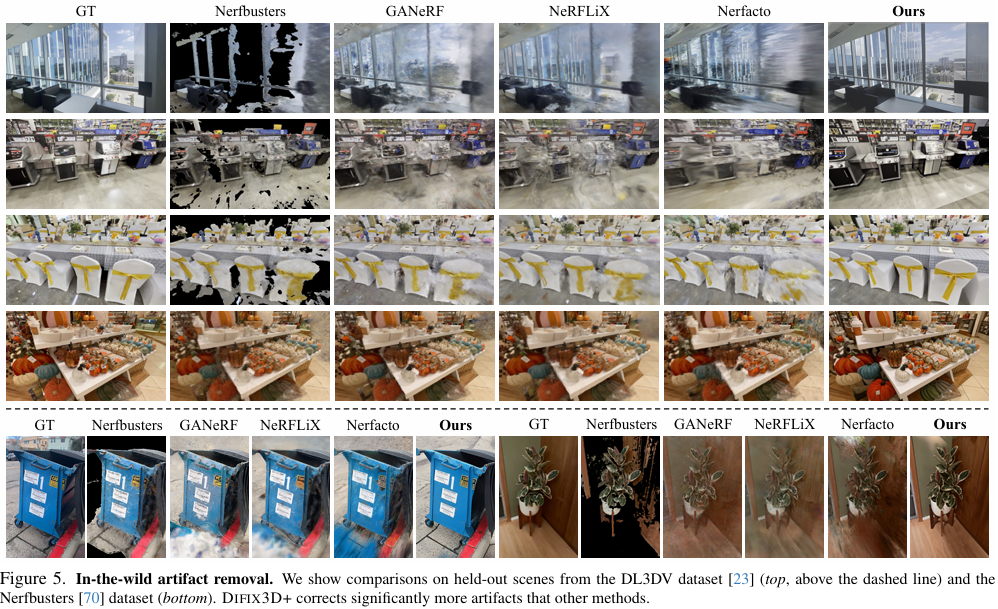

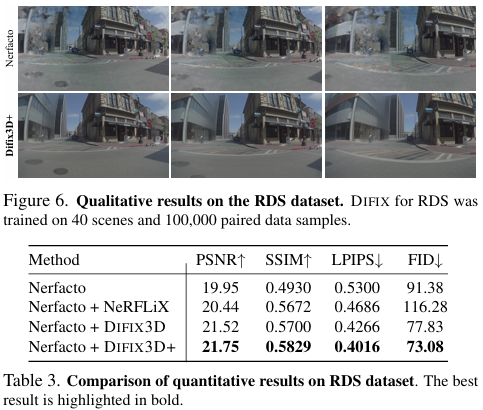
Automotive Scene Enhancement
- Automotive Scene Enhancement :
RDS (real driving scene) dataset 사용
(multi-view dataset이라서 서로 40도의 overlaps를 가지고 있는 세 개의 cameras 있음)- Difix Training :
- 세 개의 cameras 중 center camera를 reference 및 target view로 사용하고,
40 scenes 사용하여 훈련 - Data Curation Strategy로 100,000개의 noisy-clean image pair 만들어서 Difix 훈련
- 세 개의 cameras 중 center camera를 reference 및 target view로 사용하고,
- Evaluation :
- 나머지 두 개의 cameras를 novel view로 사용하고,
20 scenes 사용하여 평가
- 나머지 두 개의 cameras를 novel view로 사용하고,
- Difix Training :
Ablation Study
- Ablation Study on Pipeline :
하나씩 요소를 추가해가며 진행!- (a)
3D model update 없이
rendered views에 그냥 직접 Difix 적용- reference views에서 먼 less observed regions에서는 별로고, consistency 유지하지 못해서 flickering 발생
- (b)
non-incremental (not progressive) 3D model update
(pseudo-views를 한 번에 모두 training set에 추가하여 3D model update(distill)) - (c)
progressive 3D model update - (d)
post-rendering으로도 Difix 적용
- (a)
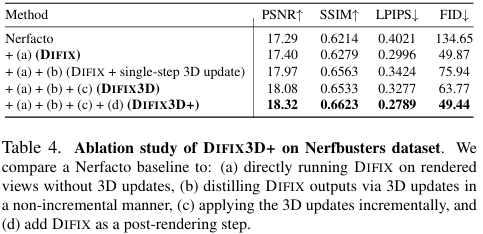
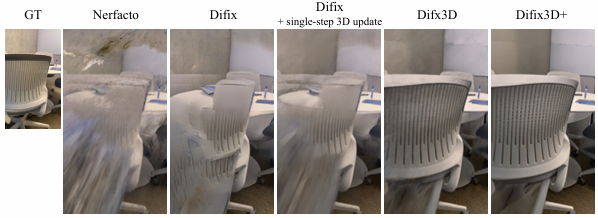
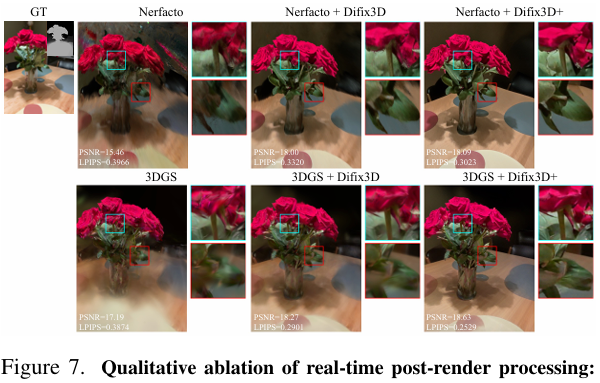
- Ablation Study on Difix Training :
-
low noise value\(\tau = 200\) 을 사용한 Difix3D+
versus high noise value \(\tau = 1000\) 을 사용한 Pix2pix-Turbo[52] - high noise value 를 사용할 경우
diffusion model이 more hallucinated (더 상상하며) GT와 다른 결과를 generate하기 때문에
poorer generalization on the test dataset
- high noise value 를 사용할 경우
-
reference view conditioning (self-attention layer)의 유무 -
Gram style loss의 유무
-

Conclusion
- Limitation :
- inherently limited by initial 3D model의 성능
- Future Work :
- initial 3D model의 성능에 의존하는 문제를
modern diffusion priors 사용하여 극복 - Difix는 single-step 2D diffusion model을 fine-tuning한 model인데,
single-step video diffusion model로 확장하여
long-context 3D consistency까지도 향상
- initial 3D model의 성능에 의존하는 문제를
Question
-
Q1 :
single-step 2D diffusion model인 Difix는
novel-view rendering이나 camera pose selection에 관여하지 않고
그냥 더러운 image를 깨끗하게 만드는 역할일 뿐인건가요? - A1 :
맞는 말씀인데, 깨끗하게 만듦으로써 distillation으로 3D model param.를 업데이트하는 역할도 있습니다.
다시 한 번 설명해보도록 하겠습니다.
Difix는 더러운 image를 깨끗하게 만들 수 있도록 fine-tuning 되었습니다.
근데,더러운 image를 깨끗하게 만듦으로써 두 가지 역할을 수행합니다.- 첫 번째는 3D model이 render한 더러운 image를 깨끗하게 만들어서 이를 다시 training image로 사용하는 과정에서 diffusion prior를 3D model로
distill하여 3D model을 update하는 데 사용할 수 있습니다. - 두 번째는 final updated 3D model이 render한 image를 마지막으로 좀 더 깨끗하게 만드는
post-processing에 사용합니다.
- 첫 번째는 3D model이 render한 더러운 image를 깨끗하게 만들어서 이를 다시 training image로 사용하는 과정에서 diffusion prior를 3D model로
-
Q2 :
한 번에 3D model을 update하는 non-incremental 방법에 비해
progressively 3D model을 update하는 방법의 성능이 더 좋은 이유는 무엇이라고 생각하시나요? - A2 :
핵심은
reference view부터 target view까지의 경로를 따라novel camera pose를 조금씩 perturb한다는 것과,
Difix의self-attention layer에 있다고 생각합니다.- progressive update의 경우에는
먼저 reference view와 가까이 있는 novel view에서 더러운 image를 render한 뒤 이를 Difix에 넣어서
self-attention layer에 의해 가까운 clean reference view의 도움으로 더러운 novel view를 쉽게 깨끗하게 만들 수 있습니다.
그리고 깨끗해진 novel view를 다시 training set (reference view)에 넣고, novel view를 reference view부터 target view까지 조금씩만 이동시키므로
마찬가지로 그 다음 novel view에 대해서도 nearby clean reference view의 도움으로 계속해서 novel view를 쉽게 깨끗하게 만들 수 있습니다. - non-incremental update의 경우에는
reference view부터 target view까지의 경로에 있는 임의의 모든 novel views에 대해 더러운 image를 한꺼번에 render한 뒤 이를 한꺼번에 Difix에 넣어서 한꺼번에 깨끗하게 만들어야 하는데,
만약reference view로부터 멀리 있는 novel view의 경우
둘의 3D content 차이가 커서 self-attention layer가 둘의 관계를 잘 포착할 수 없고 clean reference view의 도움으로 novel view를 깨끗하게 만들기가 쉽지 않습니다.
- progressive update의 경우에는